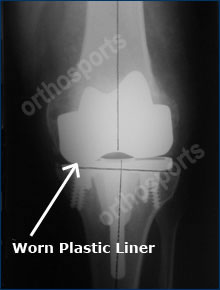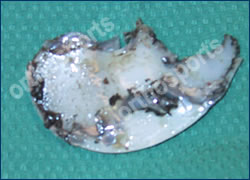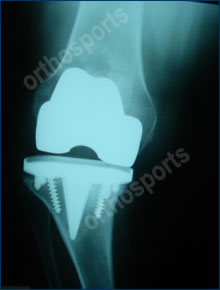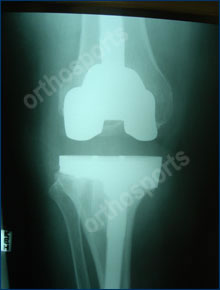Inside This section
Revision Knee Replacement
To view an animation of Revision Knee Replacement, click here.
This means that part or all of your previous knee replacement needs to be redone. This operation varies from very minor adjustments to massive operations replacing significant amounts of bone and hence is difficult to describe in full.
A knee replacement consists of a femoral component, a tibial component and a plastic insert in between and usually, but not always, a patella replacement.

X-Ray – Worn Plastic Liner

Retrieved Plastic Liner
Why Does A Knee Need To Be Revised?
- Pain is the primary reason for revision. Usually the cause is clear, but not always. Those knees without an obvious cause for pain in general do not do as well after surgery.
- Plastic (polyethylene) wear .This is one of the easier revisions where only the plastic insert is changed.
- Instability – which means the knee is not stable and may be giving way or not feel safe when you walk.
- Loosening of either the femoral, tibial or patella component. This usually presents as pain but may be asymptomatic. It is for this reason why you must have your joint followed up for life as there can be changes on Xray that indicate that the knee should be revised despite having no symptoms.
- Infection – usually presents as pain but may present as swelling or an acute fever.
- Osteolysis (bone loss).This can occur due to particles being released into the knee joint which result in bone being destroyed.
- Stiffness – this is difficult to improve with revision but can help in the right indications.
To view an animation of Revision Knee Replacement please see the video below:
Revision Total Knee Replacement

Failed Knee Replacement

Same knee revised with long stems
Investigations
- X-rays are essential and should be of good quality and show most of the femur and tibia.
- Routine blood tests especially to rule out infection.
- Bone scans can help to determine if a component is loose.
- Aspiration of the joint is occasionally done to diagnose or rule out infection.
Surgery
It will be explained to you prior to surgery what is likely to be done but in revision surgery the unexpected can happen and good planning can prevent most potential problems. The surgery is often but not always more extensive than your previous surgery and the complications similar but more frequent than the first operation.(see complications section in total knee replacement).
The knee is opened up and the problem identified. One or all of the components are removed, the bone surfaces cleaned up and new components inserted. Often augments are required to build up any bone loss or on occasion allograft (cadaver) bone may be required.
Post-Operative
Again this is similar but often a bit slower than the first knee replacement. Occasionally a brace may need to be worn. The range of motion may not be as good as a routine knee replacement.
